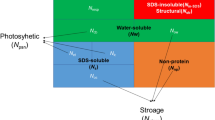Abstract
A field experiment was conducted with flue-cured tobacco,Nicotiana tabacum L., to examine the hypothesis that after removal of the reproductive tissues (top**), which is coincident with rapid depletion of soil nitrate, the growing apical leaves receive their N primarily from older, senescing leaves. On the 83rd day after transplanting (crop day 83) the nitrate remaining in the plow layer was leached downward and replaced with an equivalent quantity of15N-labeled nitrate. Theoretically, any N taken up by the plants thereafter could be distinguished from the endogenous N present in the plant on crop day 83, thus allowing remobilization of the latter to be estimated. However, some soil N remained accessible to the plants throughout the remainder of the growing season, and as a consequence may have limited the remobilization of endogenous N. Plants were harvested and sectioned into 11 different plant parts at six intervals up to crop day 127. The nitrogen in each plant tissue was fractionated into nitrate-N, soluble reduced-N (SRN), and insoluble N (IN). Tissue nitrate, which accounted for less than 0.7% of total N in the tissue, remained relatively constant throughout the 44 day period. In contrast, SRN and IN fluctuated appreciably. During a 6-day period of water stress, 25% of the IN in the root and leaf lamina was hydrolized to SRN. It was postulated that the drought initiated a type of reversible senescence in which protein was hydrolyzed to amino acids, thereby increasing the osmotic potential of the tissues and improving cell survival. During recovery from water stress, SRN was reincorporated into IN in all tissues except the lower leaves, which were senescing. Root growth was predominant during this period and was supported by N remobilization from the lower leaves and root stump. After subsequent harvest of the lower and middle leaves, growth of the remaining upper leaves was supported in part by remobilization of N from the adjacent stalk tissue.
Similar content being viewed by others
References
Beevers L 1976 Nitrogen metabolism in the whole plant.In Nitrogen Metabolism in Plants. Eds. E J W Barrington and A J Ellis. pp 247–275. Edward Arnold Publishers, Ltd., London.
Boussiba S and Richmond A E 1976 Abscisic acid and the after-effect of stress in tobacco plants. Planta 129, 217–219.
Dunn C A 1973 The Interdependence between Nitrogen and Carbohydrate Metabolism in Relation to Natural and Induced Senescence inNicotiana tabacum L. Ph.D. thesis, North Carolina State University, Raleigh.
Goenaga R J, Long R C and Volk R J Uptake of nitrogen by flue-cured tobacco during maturation and senescence I. Partitioning of nitrogen derived from soil and fertilizer sources. Plant and Soil 121.pages
Hsiao T C 1973 Plant responses to water stress.In Annual Review of Plant Physiology. Eds. W R Briggs, P B Green and R L Jones. Vol. 24, pp 519–570. Annual Reviews, Inc., Palo Alto, California.
Huffaker R C 1983 Protein metabolism.In Plant Physiology. Ed. F C Steward, Vol. 8, pp 267–333. Academic Press, Inc., Orlando, Florida.
Long R C and Weybrew J A 1981 Major chemical changes during senescence and curing. Rec. Adv. Tob. Sci. 7, 70–74.
Milborrow B V 1984 Inhibitors.In Advanced Plant Physiology. Ed. M B Wilkins. pp 76–110. Pitman Publishing, Ltd., London.
Noodin L D 1980 Senescence in the whole plant.In Sensescence in plants. Ed. K V Thimann. pp 219–258. CRC Press, Inc., Boca Raton, Florida.
Papenfus H D and Quin F M 1984 Tobacco.In The Physiology of Tropical Field Crops. Eds. P R Goldsworthy and N M Fisher. pp 607–636. John Wiley and Sons, Ltd., Somerset, NJ.
Tully R E, Hanson A D and Nelsen C E 1979 Proline accumulation in water-stressed barley leaves in relation to translocation and the nitrogen budget. Plant Physiol. 63, 518–523.
Wardlaw I F 1980 Translocation and source-sink relationships.In The Biology of Crop Productivity. Ed. P S Carlson, pp 297–333. Academic Press, Inc., Orlando, Florida.
Weybrew J A, Long R C, Dunn C A and Woltz W G 1974 The biochemical regulation of ripening of tobacco leaves.In Mechanisms of Regulation of Plant Growth. Eds. R L Bieleski, A R Ferguson and N M Creswell. pp 843–847. The Royal Society New Zealand, Wellington.
Wittenback A V, Sin W and Herbert R R 1982. Vascular localization of proteases and degradation of chloroplasts in mesophyll protoplasts from senescing primary wheat leaves. Plant Physiol. 69, 98–102.
Author information
Authors and Affiliations
Additional information
Paper No. 11641 of the journal series of the North Carolina Agricultural Research Service. Raleigh, NC 27695-7601. Part of a thesis submitted by the senior author in partial fulfillment of the requirements of the Ph.D degree.
Rights and permissions
About this article
Cite this article
Goenaga, R.J., Long, R.C. & Volk, R.J. Uptake of nitrogen by flue-cured tobacco during maturation and senescence. Plant Soil 120, 141–147 (1989). https://doi.org/10.1007/BF02370300
Received:
Revised:
Issue Date:
DOI: https://doi.org/10.1007/BF02370300




